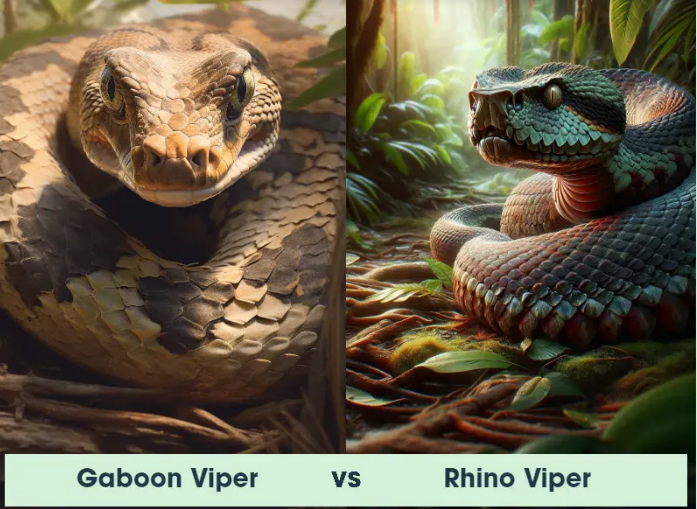Climate change and human encroachment into the Kakamega Forest are major factors threatening the existence of numerous animal species, particularly two unique venomous tropical snakes: the Gaboon viper (Bitis gabonica) and the Rhinoceros horned viper (Bitis nasicornis), as highlighted by environmentalists from Kakamega.
The two serpents are nearly identical, with the Rhinoceros horned viper being slightly shorter than its cousin, the Gaboon viper (adults reach up to 4 feet (1.2 meters) in length, while females may grow to 5 feet (1.5 meters)
Their feeding habits are almost identical because they rely on their venom to hunt prey.
Both species feed on a variety of amphibians, mammals, and birds, such as doves, guineafowl, and francolins.
Additionally, they hunt many different species of rodents, including field mice and rats, as well as hares and rabbits.
In response to these challenges facing them in the Kakamega habitat, stakeholders have initiated a program to fence the forest with an electric barrier to control human movement into and out of the forest, aiming to mitigate the impact of encroachment.
Covering an area of 23,777.3 hectares in Western Kenya, Kakamega Forest serves as a natural habitat for 33 species of snakes and various other indigenous animals.
It stands as one of the last remnants of the larger Congo Forest, which is believed to have once covered the entire equatorial region of Africa.
This initiative underscores the urgent need for proactive measures to protect the biodiversity of Kakamega Forest and preserve its delicate ecosystem amidst growing threats.
The Gaboon Viper stands out as one of the most unique venomous snakes globally, boasting the longest fangs measuring up to five centimeters and possessing the highest venom yield among all known venomous snakes.
Features
Similarly, its counterpart from the same Bitis family, the Rhinoceros Horned Viper, possesses distinct features, including elongated nostrils reminiscent of the horns of a rhinoceros.
This viper employs its striking coloration to blend into its natural environment, aiding both in hunting prey and evading potential threats.
Despite their remarkable adaptations, the populations of both the Gaboon Viper and the Rhinoceros Horned Viper have experienced significant declines over the past two decades.
This decline underscores the pressing need for conservation efforts to safeguard these unique and ecologically vital species.
Abraham Imbayi, an environmentalist and officer at Kakamega Forest, emphasizes that fencing will not only reduce human interference but also ensure proper management of the ecosystem.
“In Kenya currently, it is only in this forest you would find these two snakes. They are highly venomous, but sadly few. The fencing will allow their natural habitat to be safe from interference,” said Mr. Imbayi.
The presence of these two unique snakes has attracted researchers from across East Africa, who often camp at the forest to study their behaviors.
However, the rapid reduction in the snake population poses a significant threat to this scientific interest.
The decline in their numbers underscores the urgency of conservation efforts to protect not only the Gaboon viper and Rhinoceros horned viper but also the biodiversity of Kakamega Forest as a whole.
“There are researchers who visit the forest just to conduct research on the venomous snakes. If they are not protected, then we shall lose a lot as a country and as a community. The fencing of the forest is timely,” said Imbayi, also a member of the local community.
Human/Animal conflict
Fencing of Kakamega Forest will also keep the community members safe from dangerous animals. Most of the villagers sneak into the forest to look for dry wood for fuel without the knowledge of the forest management.
“The forest is vast and sometimes some people get into the forest without our permission. By fencing the forest, we shall also limit the interaction between humans and the venomous snakes,” says Imbayi.
Communities living around the forest have different interests; some are positive while others are negative. With a history spanning centuries, there are traditional religious sects that worship and conduct ceremonies in the forest.
“There are those who are looking for firewood. Others are using the forest for cultural practices, while others are looking for grazing fields. When the fencing is done, it would not deny people the opportunity to use the forest but control the entry. Just like a home, we fence to control movement in and out in an orderly manner,” he added.
The organizations partnering to ensure the forest is fenced include Kenya Forest Service, Kenya Wildlife Service, Kakamega and Vihiga Counties, Rhino Ark, UNDP, Muleshi Community Association, and the Government of Japan.
“The electric fence will cover the first 15km of the forest in the first phase, then others will follow. Demarcation of the boundary is currently ongoing,” said Mr. Imbayi.

